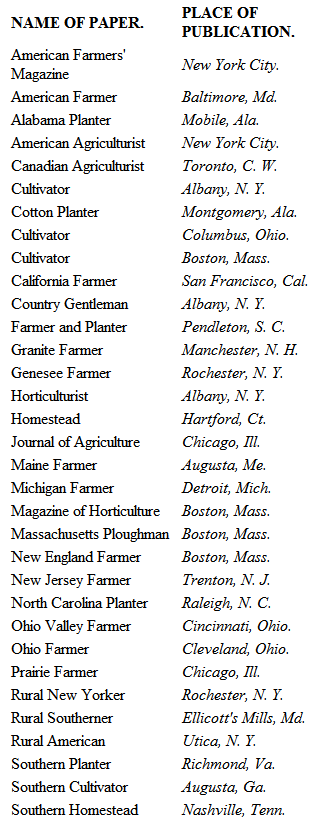 Полная версия
Полная версияSoil Culture
Prepare the cask by burning in it a strip of paper or muslin, dipped in melted sulphur, and suspended by a wire across the bung-hole. Fermentation commences very soon and will be completed within a few days or weeks according to the temperature. Its completion is marked by the cessation of the escape of gas. No sugar, brandy, or any other substance, should be added to the grape-juice to make good wine. They are all adulterations. The wine having settled after this fermentation, may be racked off into clean casks, prepared as before. A second fermentation will take place in the spring. It should not be bottled until after this second fermentation, as its expansion will break the glass. While in the casks they should always be kept full, being occasionally filled from a small cask, kept for the purpose. When this fermentation ceases, bottle and cork tight, and lay the bottles on their sides, in a cool cellar. The wine will improve with age.
Sometimes it remains on the lees without racking and is drawn off and bottled. Frequently the wine does not become wholly clear and needs fining. Various substances are used for this purpose, as fish-glue, charcoal, starch, rice, milk, &c. The best of these substances is charcoal, or the white of eggs and milk. Add by degrees according to the foulness of the wine. An ounce of charcoal to a barrel of wine is an ordinary quantity; or a pint of milk with the white of four eggs—more or less according to the state of the wine.
Rhine Wine of Germany may be made as follows:—
Take good Catawba or Isabella grapes, and pound or grind them so as to crush every seed and leave them in that state for twenty-four hours. Fumigate the cask by burning strips of muslin dipped in sulphur as in the preceding recipe. Strain or press out the juice into the cask filling it and keeping it entirely full, that impurities may run out of the bung, during fermentation. In the spring prepare another cask in the same way and rack it off into that. When a year old bottle it and it is fit for use.
Sweeter wines than any of the above are made by adding sugar to the must before fermentation. It should be double-refined sugar, and still it is an adulteration.
WOODLANDS
One of the greatest errors of American farmers is their neglect to cultivate groves of trees for woodlands, in all suitable places. Our primeval forests have been wantonly destroyed, and the country is not yet old enough to feel the full force of neglecting to replenish them, by new groves, in suitable localities. On the points of hills, rough stony places, sides of steep hills, ravines that can not be cultivated, and by the side of all the highways of the land, trees should be cultivated: in some places fruit-trees, but in most places forest-trees. The advantages would be manifold; they would afford shade for cattle, groves for birds, which would destroy the worms; they would break off the cold winds from crops, cattle, fruit-orchards, and dwellings; would greatly enrich the soil by their annual foliage, afford abundance of fuel at the cheapest rates, give much good timber, provide for fine maple-sugar, and be the greatest ornaments of the rural districts. Only think of the comfort and beauty of fifty miles square, in which not a street could be found which had not trees on each side, not more than twelve feet apart. When such trees should become twenty years old, the pedestrian or the carriage could move all day in the shade, listening to the music of the birds, and inhaling the aroma of the foliage or flowers. To every owner or occupant of the soil we say, plant trees.
POULTRY
Fattening and preparing poultry for the market are important items in rural economy. Plenty of sweet food and pure water given at regular times, and the fowls not allowed to wander, are the requisites of successful fattening. The best feed for fattening fowls is oat-meal. Next to this is corn-meal. Three things are essential in food for fattening animals, flesh-forming, fat-forming, and heat-producing substances. Of all the grains ordinarily fed, oat-meal contains these in the best proportions, and next to this comes yellow Indian corn meal. Fat is good, but must be given in a hard form as in mutton or beef suet. Rice boiled in sweet milk, fed for a day or two before killing fowls is said to render the flesh of a white delicate color.
At least one third of the value of poultry in the market depends upon properly preparing and transporting it.
1. Do not feed fowls at all for twenty-four hours before killing them.
2. Kill by cutting the jugular vein with a sharp pen-knife, just under the sides of the head, and hang them up to bleed.
3. Pick carefully and very clean, without tearing the skin, and without scalding. Singe slightly if need be. Dip in hot water for three or four seconds and in cold water half a minute.
4. Do not open the breast at all, but remove the entrails from the hind opening, leaving the gizzard in its place. Put no water in but wipe out the blood with a dry cloth. Leaving the entrails in is injurious, tending to sour the meat and taint it with their flavor.
5. Do not allow your poultry to freeze by any means. For transporting to a distant market, pack in shallow boxes never containing over three hundred pounds each and in clean straw without chaff or dust, and in such a manner that no two fowls will touch each other.
6. Geese and ducks look better with the heads cut off. But all fowls having their heads removed must have the skin drawn down and tightly tied over the end of the neck bone. This will preserve them well and give a good appearance.
To preserve fowls for a long time in a perfectly sweet condition for family use, fill them half full or more with pulverized charcoal, which will act as an absorbent and prevent every particle of taint.
AGRICULTURAL PERIODICALS
The following list of Agricultural Periodicals embraces all that have come to our knowledge. In a subsequent edition we shall endeavor to render the list more complete, and give the special design of each, with the frequency of publication, form, price, editor's and publisher's names, etc.





